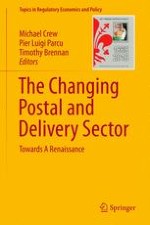2017 | OriginalPaper | Chapter
An Examination of the Links Between Postal Price Constraints, Efficiency, Competition and Public Welfare
Authors : Philippe De Donder, Frank Rodriguez, Soterios Soteri
Published in: The Changing Postal and Delivery Sector
Publisher: Springer International Publishing
Activate our intelligent search to find suitable subject content or patents.
Select sections of text to find matching patents with Artificial Intelligence. powered by
Select sections of text to find additional relevant content using AI-assisted search. powered by
